In June the employees of Singapore’s 1880 Club had a rude awakening: the eight-year-old private members’ institution had closed down without warning. Marc Nicholson, its founder, chalked it up to a drop in attendance and lower spending by members. Its Hong Kong branch had closed two weeks earlier after just seven months in operation; its Bali outpost, meanwhile, never saw the light of day, with construction coming to a halt late last year. And 1880 isn’t alone. Singapore’s country clubs, which sprouted up in the 1980s and 1990s, have been struggling to keep up too. A few days ago, four of them hit the rough when the government chose not to renew their golf-course leases. There’s a common thread: stop by places like these today and you’ll be hard pressed to find a young person. Members have grown old and these once sought-after “third spaces” are now on a slow march into obscurity.
But not all of them. Two of Singapore’s leading private members’ clubs are still chasing growth. The Mandala Club, renowned for a string of Michelin-starred chef pop-ups, is expanding its footprint by 50 per cent and has a new club-hotel concept in Bali under way. And 67 Pall Mall, founded in London, is even more aggressive: not only is it about to open a Shanghai branch but it has also announced ambitious plans to launch further locations in the next two years.
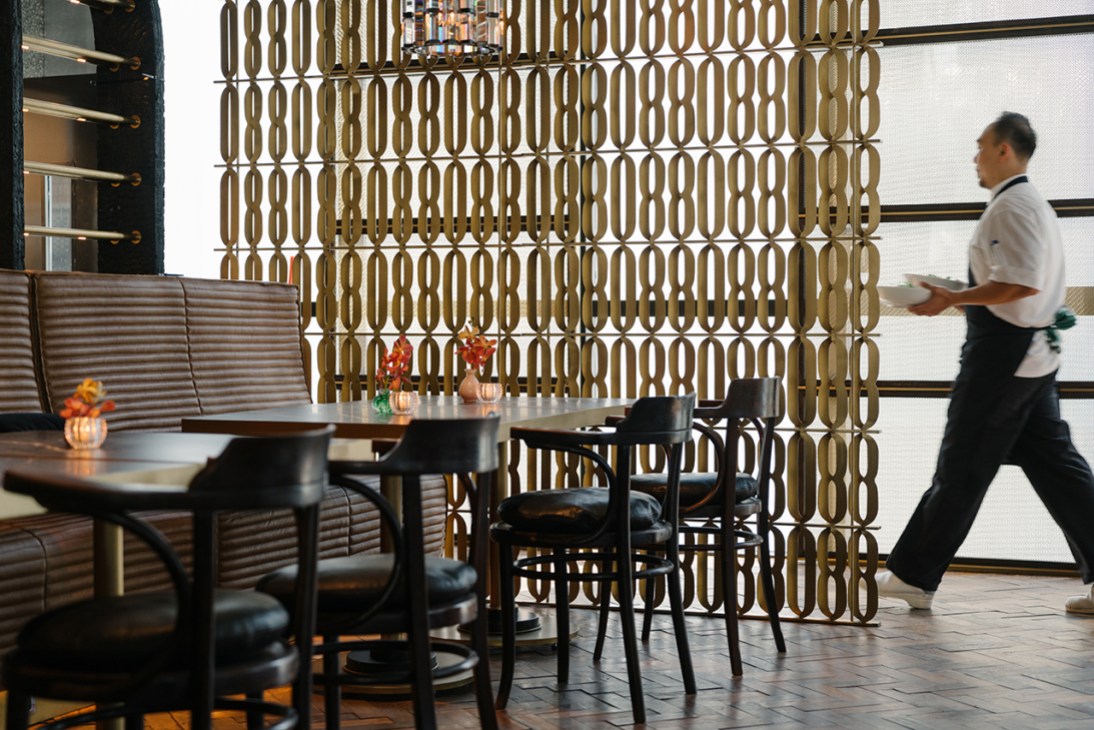
So what’s behind the contrasting fates? In an age when almost everything is mediated by screens, isn’t actual face time sought after more than before? These two thriving Singapore-based clubs show that the trick to getting a community right is to find a niche, then make what you offer feel part of your environment.
That’s what 67 Pall Mall Singapore, a club centred around fine wine, has captured in a bottle. Its founder, Grant Ashton, could have replicated the successful London flagship but he chose instead to ensure that the Singapore outpost catered to local audiences. “So much of what we do is personal – 67 Pall Mall here is not a cookie-cutter club,” he says. “It’s aimed at Singaporeans.” To satisfy residents’ thirst for cerebral pursuits, it holds masterclasses and events that enable members to learn while sipping wine. “A big piece of what we do is making sure that people are getting more than just entertainment,” he adds.
While many establishments have sought the patronage of business leaders who want privacy and discretion, The Mandala Club has taken a different route. “People sign up because they share the same values as us; it’s not exclusive for exclusivity’s sake,” says Ben Jones, the CEO and co-founder of The Mandala Group. Jones keeps a lookout for Singapore’s young entrepreneurs. “The start-up environment is huge here and we’ve got a thriving under-30s member base,” he says. The club runs a mentorship series in which unicorn start-up founders or executives from multinational companies share their advice. Jones came up with these programmes after spending time walking the grounds, making introductions and matchmaking up-and-comers with experienced heads. “I’m here all day, every day,” he says. “We are very hands-on and recognise that this isn’t necessarily a product that you can scale too much.”
Two weeks after 1880’s closure, its former employees announced that they would open a new club in the same venue with the landlord’s backing. It goes to show that there’s an appetite for clubs done well. Offering familiarity and friendship in a world that can feel in a constant state of flux is no small feat. But entertainment has a short shelf life – success lies in diversity and well-considered offerings that have a meaningful sense of place. If you can master that, where can we sign up?
Koh is a regular Monocle contributor. In need of a drink in Singapore? Check out Monocle’s City Guide here. For more opinion, analysis and insight, subscribe to Monocle today.
When was the last time you took a beat and just sat back? When did you last steal a few moments from the crush and thrum of city life to watch things pass? I’m told urban living is busy but taking a load off is my forte. I’m also quite proud of myself. I have weathered difficult times, I put my back into my work and I’m there when people need me. I’m told that I can be very supportive. Yes, I’ll admit that I can be stuck in my ways – a little wooden at times – but compared to those around me, I have a rather sunny outlook. Oh, I should perhaps clarify at this point that I am a park bench.
I’m not sure how long I’ve been in my current position but the trees around me have budded, blushed and shed their leaves countless times since I first set carved foot in this city park. The chirp of the birds and the hum of the high-street traffic is a soundtrack to which lives have unfolded on and around my slatted lap. I’ve heard the reassuring morning natter of neighbours who rest with me during morning saunters, and provided sanctuary for joggers, toddlers and oldsters. Most are lovely but, in my line of work, you come rather close to a few arseholes now and again.
I’ve seen crying babies, sore knees, spilled coffees, mudpies, quiet cries – two marriage proposals (one consummation) and a catalogue of incidents that you wouldn’t believe if I told you. Not everything that happens in cities is pretty. In some small way, though, I like to think I’ve helped. My haunches, painted iron sides and sturdy seat board are a little mucky but I can still offer succour to plumbers and poets alike. I’m a democrat at heart and wouldn’t discriminate against those I spend time with. I could, however, live without those pesky pigeons using me for target practice, I’m a bench; spare me the stool.
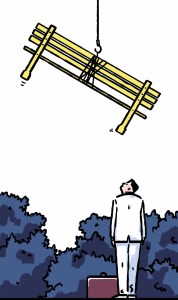
Now I’m not what you would call well-travelled but I have a hunch that my kind has been around almost as long as yours has. Human history, I’m told, is all about movement but since merchants first traded, people massed and cities convened, your kind has relied (at times heavily) on mine for relief.
As a public bench, I’m more civic-minded and less doctrinaire than the church pews I’ve heard about, and less courtly than my cousins in parliaments or palaces. I’m rougher around the edges than the newer, more ergonomic breeds I’ve glimpsed in magazines (people leave the darnedest things on benches). But it’s a proud history: my stone-and-marble forebears were in ancient Athens at the birth of democracy.
Much more recently, the arrival of my spindly-legged relatives marked a democratic shift in urbanism as public benches popped up around the world, lining the boulevards of Haussmann’s Paris, Central Park in New York and dotting the banks of the Danube in Budapest.
We might not always say it but public seating is a mark of civility and shared humanity. A benchmark, if you will, of co-operation.
Which brings me to my biggest fear. A neighbour of mine from down the way has told me about a worrying new trend. In my native London, there’s a design known as the Camden Bench. The thought shivers my timbers. Launched in 2012, the unsightly concrete carbuncles are the apotheosis of what you humans have dubbed “hostile architecture”, bits of the built environment designed to discourage lingering too long. It deters littering, drug dealing and rough sleeping, and can serve as a roadblock. But a bench that rebuffs sitters? Have you ever heard such a thing? It might be my Victorian values shining through but this just doesn’t sit right with me.
Luckily, you lot aren’t taking this sitting down either and a wealth of competitions are helping to create and install welcoming new designs. We park benches – donated, commissioned, old, new, flaking and freshly painted – remain an unsung player of public life. What would the films Forrest Gump or La La Land be without us? And shouldn’t there be a supporting role award out there for a Dame Judi Bench? We’re there holding up the plot of spy novels and in paintings by Manet and the photography of Brassaï. Success is about bums on seats. We benches are a rare thing: a place to be still amid the bustle and by ourselves but with others. I sometimes catch myself daydreaming about what life might be like beyond the rat race, rubbish and out of earshot of the car horns. Unlike the benches across the way, my life isn’t always a picnic. What if I found somewhere to perch on a quiet country lane or leafy village green? But who am I kidding? The countryside just isn’t for folks like you and me; I’m old but I’m not useless yet. Technology might have changed but I still matter. And if you want me, I’ll be here to lean on.
About the writer
For all its plus-points, a park bench might struggle to tell its own story. This one, which has chosen to remain anonymous, spoke (between sittings) to Monocle’s editor, Josh Fehnert. This essay, and plenty more city-focused ideas are available in The Monocle Companion: Fifty Ideas For Building Better Cities. Buy your copy today.
Pope Leo XIV has quit the heat of the Vatican and taken up residence in Castel Gandolfo, a papal property that sits atop a hill southeast of the city, with a calming view of Lake Albano. He’ll be there until 20 July and has also booked himself in for a long weekend in August.

Leo’s departure from the sultry Holy See has made the news because his predecessor, Pope Francis, was not a Gandolfo man and declined to spend his summers there (indeed, he displayed little interest in most of the potential perks of the job, eschewing much of the ceremonial regalia and even moving out of the papal apartments in Vatican City). Unsurprisingly, the locals are delighted that Leo has embraced this summer pope-on-the-move tradition that dates back to 1626, even if there is still no official Leo trinketry for them to sell in the souvenir shops.
Leo, aka Sporty Pope, is expected to fit in some tennis and find a spot of downtime. But he’s unlikely to have an out-of-office (OOO) message set on his laptop – the American Pope reportedly has a habit of staying up to 03.00 sending messages on Whatsapp. Plus, he has his first encyclical to bash out.
And in this, the Pope reveals himself to be a man of our times. For while he might be more associated with Holy Weeks, he is, like many of us, also a paid-up practitioner of “holi-work”, that limbo in which you are definitely not in the office but have also not been able to – or, in some sad cases, even wanted to – fully sever the umbilical cord to the day job (despite the fact that you are suddenly reading your work correspondence while dressed in pink swim shorts and little else – a look that even our most fashion-forward staff couldn’t get away with at Midori House).
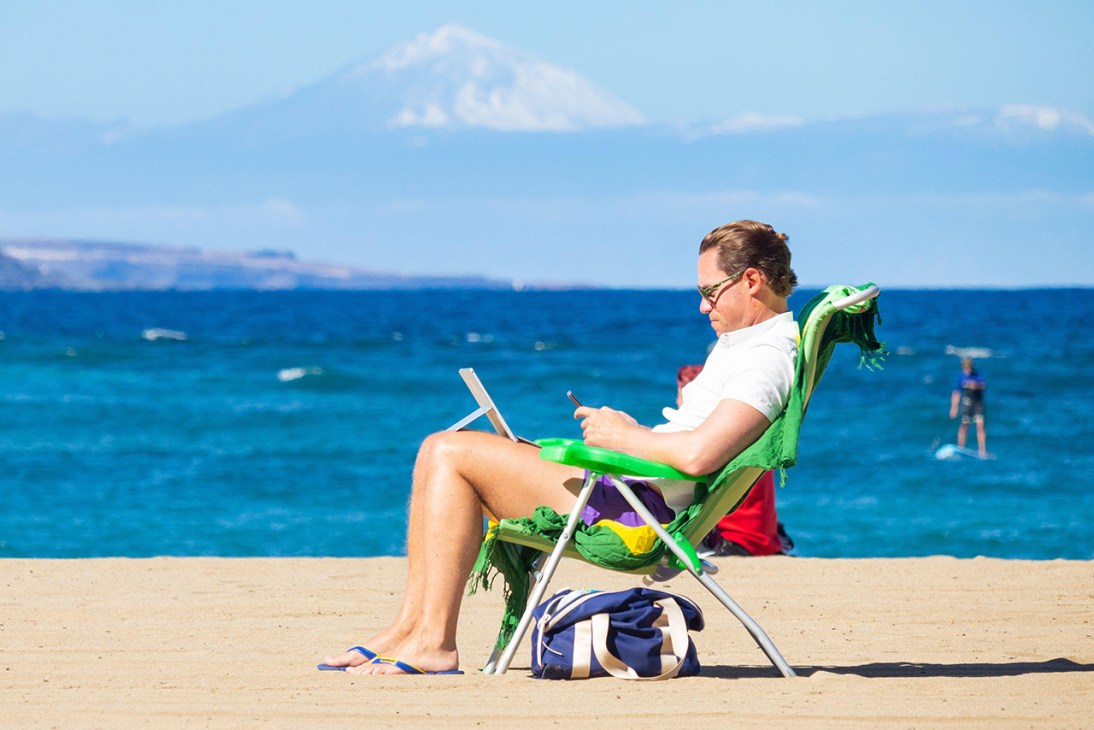
In recent years, many countries have passed so-called “right-to-disconnect” laws to ensure that employees – even popes, I imagine – can ignore work-related emails while on their holidays. But for many folks, trying to totally disconnect, to put out of their minds what might be lurking in their ever-expanding inbox, is more anxiety-inducing than giving it a daily scrub-down.
For many years, Monocle staff didn’t set up OOO messages. In the early days, when we were a fledgling brand with a tiny team, we worried about a commercial contact going elsewhere, a reporter with a great story not waiting around for our response. Now fully embraced, OOO notes have had no detrimental effects but their use is still a little haphazard because of people like me.
This weekend I leave the city for a couple of weeks. While there’s no castle involved or encyclical to write, I know that the line between my work and private lives blurred long ago and that I will also definitely want to file my column, check my mail, be a little on. In part, it’s because I remember a time before all of this, when I would return from long travels wondering whether my company was still afloat and my job still there.
Perhaps that’s the important bit. Vacations should be when you decide what makes the perfect cocktail of your time – is it a zero-per-cent-work concoction or something a little trickier to mix just right, a “holi-work special”? And here’s a line that a Protestant rarely types: I’m with the Pope on this (though I imagine that I might be having more real cocktails than him). Some writing, some downtime and some exercise will be just the ticket. But I can’t go along with Whatsapping in the middle of the night. Isn’t there a nun who can take away his phone at bedtime?
In a world that feels more unpredictable by the day, who craves a crystal ball more than insurers? From climate disasters to political shocks, risk is everywhere – and for insurance companies, reading the future isn’t a luxury – it’s the business model.
To understand how they’re making sense of it all, Monocle sat down with Gilles Moëc, chief economist at AXA Group. The French insurance giant operates in some 50 countries and Moëc leads the in-house team tasked with spotting trouble before it hits.
He splits his time between Paris and London, and is disarmingly calm for a man who describes his job as “worrying constantly”. We asked him about climate policy, the return of Trump, AI and whether Europe’s big defence spending spree might actually be a good thing.
What does your day-to-day look like as chief economist?
Producing scenarios and worrying constantly is a definition of what I do. Insurers tend to stress about “what-ifs”. For instance, we pay a lot of attention to the global fight against climate change, which is one of the most critical drivers shaping the world economy today.
It’s now half a year into president Donald Trump’s second term. How worried are you about the backlash against renewable energy in the US?
The understanding back in October and November of last year was that although some of the Biden administration’s subsidies for solar and wind power would be eliminated, most of the decarbonisation efforts would continue because many of the projects were going to be implemented in Republican states. Now that we have the final version of the ‘big, beautiful bill’, we know that most projects are going to be dead in the water. During the first mandate, there were no big changes in the speed of decarbonisation. This time, it looks different.
Do you see environmental concerns and decarbonisation falling behind in the pecking order in Europe as well?
I’m quite optimistic about that, because economic, environmental and geopolitical interests are aligned across Europe. The US is now the biggest producer of oil and gas in the world. Every year, Europe spends between two to three per cent of its hard-earned GDP on importing fossil fuel from the rest of the world, which puts us in a fragile position, as we saw when the war broke out in Ukraine. So for us, decarbonisation isn’t just our contribution to the fight against climate change. It’s also a way to make progress towards geopolitical sovereignty, as it is a way to save money in the future.
What are France’s economic strong suits?
Compared to many big European countries, France still has a demographic vitality that you can’t find elsewhere. The country produces a disproportionate number of global brands and companies. France is also one of the very few countries close to achieving energy sovereignty, and we can offer companies operating in the nation electricity costs that are more attractive than a lot of other locations.
What are the French economy’s weaknesses?
First, education. It used to be one of our key assets but the system has deteriorated, and it needs to be addressed because it concerns our long-term growth. The second is our ageing population. Even if we are in a better demographic position than many other European countries, we also have a fairly generous welfare system that doesn’t cope well with ageing. Taken together, these two issues are going to pose significant fiscal challenges that need to be dealt with.
How does AI fit into this picture?
France is in a fairly good position. There’s an established start-up culture and we already have an AI producer. The key is not only having companies that develop AI solutions but also ensuring their adoption. Digitalisation in general happened faster in France than in Germany, so I’m hopeful that, even if we are not among the top producers or innovators in the technique itself, we can at least adopt it quickly. You also need to have a government that allows exploration before regulating. In Europe – it’s not only a French problem – we very often have the reflex of regulating before we’ve seen implementation. This is where we need to take a hard look at ourselves.
Do you see the growing consensus that Europe needs to invest massively in its defence industry as a positive economic development?
Some extra spending will have a positive multiplying effect on our economy. Military equipment manufacturers employ high-skilled blue-collar workers at a time when there are very few sectors that do. And there will most likely be some developments in productivity.
The Apollo Program in the US, for example, had an effect not just on productivity through new research but it also forced American companies to follow some innovative management and quality-control techniques. Additional investment is not going to change the face of the European economy but it can benefit it.
Here in Marseille, we’re usually grateful for the cooling breeze that blows in from across the Mediterranean. However, this week the wind fanned a wildfire burning on the city’s hinterland. The blaze was soon at the gates of France’s second city and led to emergency evacuations, damage to scores of homes, the airport’s closure and the disruption of rail connections to Paris. On Tuesday lunchtime in my quartier in central Marseille, the sun suddenly turned an incensed orange as billowing clouds of smoke rose from the city’s northern flank. My throat grew scratchy and my eyes began watering. Local authorities later advised residents to stay indoors and keep all windows closed.
Many of us who live in the south of France have been factoring the risk of wildfires into our summer plans for some time now. Rising temperatures and more frequent heatwaves are key factors but the French authorities note that human activity is by far the most common trigger of such infernos. Government figures suggest that 90 per cent of blazes in the country are caused by negligence. The interior minister, Bruno Retailleau, repeated this sobering statistic when he arrived in Marseille this week, warning the public of a “high-risk” summer.
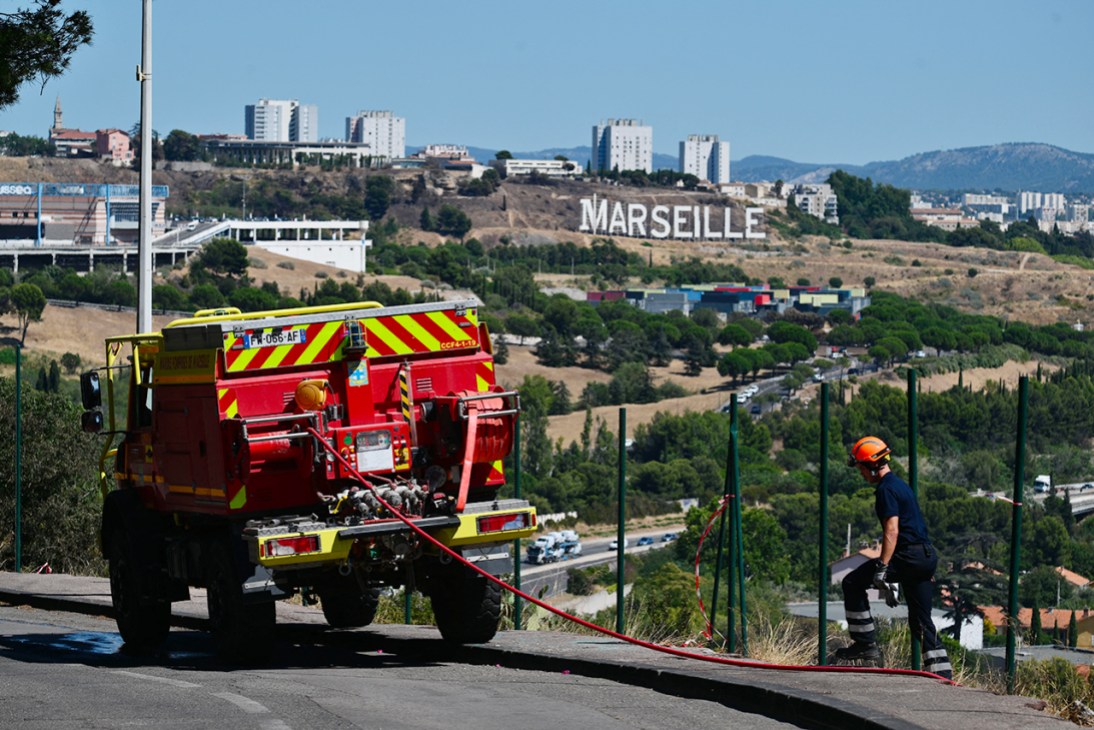
Two years ago, while reporting for Monocle, I gained some insight into how the increasing frequency – and ferocity – of wildfires is spurring France to action. In Velaux, a village about 35km from Marseille, thousands of firefighters have been trained at a special facility for learning how to tackle forest fires. The centre features a unique simulation site dotted with tree-like metal structures that erupt in gas-powered flames.
“In the Mediterranean region, we have been confronted by such fires for a long time but the season is getting earlier and earlier every year,” Jean-Luc Beccari, the director of the Departmental Fire and Rescue Service of Bouches-du-Rhône, told Monocle. But the longer-term trajectory in France and elsewhere in Europe looks ominous: a UN report projects that wildfires on the continent will increase by 30 per cent by 2050.
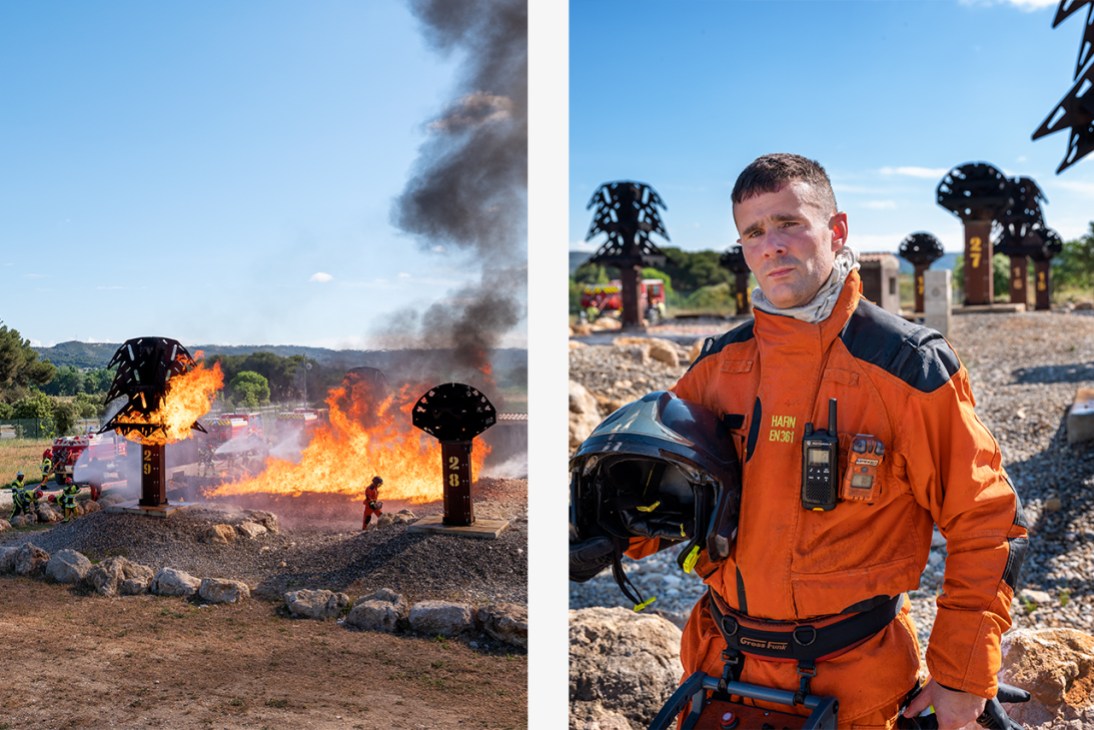
While France is trying to persuade more people to sign up as volunteer firefighters – some estimates predict that a further 50,000 will be required by 2027 – it’s also trying to tackle the issue with legislation. In 2023, French parliamentarians voted to outlaw smoking in all forests and woodlands during periods of elevated risk. That ban built on an existing law forbidding the lighting of fires within 200 metres of wooded areas.
Staff members in Velaux told me that their wildfire simulation site was the only one of its kind in Europe. They’re keen to share lessons with other nations across the continent experiencing an uptick in wildfires. In countries from Spain to Greece, towns and governments can learn from France’s focus on raising public awareness, investing in specialised training centres and encouraging recruitment and volunteering. As Beccari put it, “This is a collective challenge that affects us all.”
Fitzgerald is Monocle’s North Africa Correspondent. For more opinion, analysis and insight, subscribe to Monocle today.
Germany’s legacy administrative systems almost ruined my wedding. I have many fond memories of the build-up to the big day but also one terrible recollection: having to gather a pile of paper documents from offices across Germany to submit to the registry in Munich. Fortunately, this laborious task didn’t scupper our plans – but it was illustrative of how outdated systems are stymying the entire country.
We might be the world’s third-largest economy with enviable engineering prowess but our bureaucracy and systems are notoriously analogue. So many of the processes that citizens rely on involve pieces of paper locked away in filing cabinets or make use of software that’s regarded as obsolete in many other countries. This was underlined by the coronavirus pandemic, during which the German government was derided for trying to do contact tracing using fax machines.
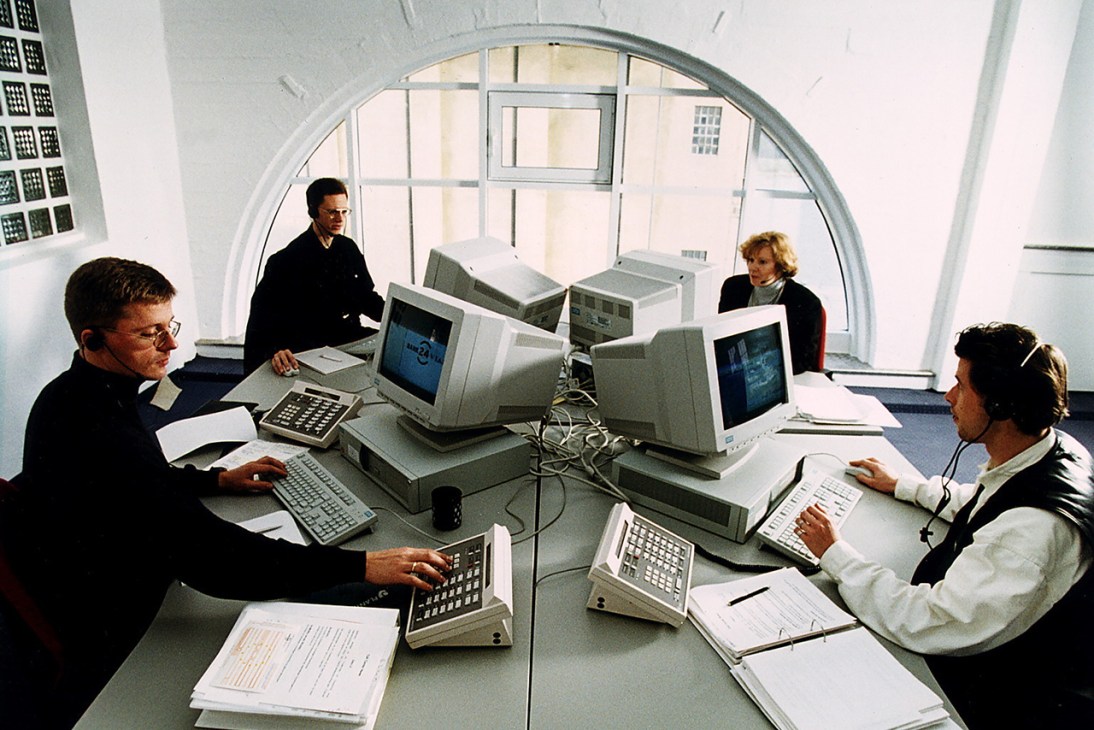
More recently it emerged that Deutsche Bahn, the national railway, still uses a decades-old computer operating system. The World Digital Competitiveness Ranking, published by the International Institute for Management Development in Switzerland, puts Germany at a tragic 23rd place out of 67 economies. A 2024 study by the Ifo Institute, an economic think tank, showed that if Germany caught up with Denmark in digitalising its administration, its GDP would grow by €96bn.
Our underdevelopment on this front is symptomatic of a dispersed political structure. After the fall of the Nazis, the country went to great lengths to avoid centralising power, giving a lot of autonomy to states and cities. This often meant that they developed separate software packages to run local services, as well as their own ways of doing things. Such fragmentation still hinders co-operation. A long-held commitment to data protection has further hampered the adoption of digital services.
Amid an expected third consecutive year of recession, Germany is currently in the process of rewriting the rules of how it is run. It has been working to loosen its previously airtight fiscal rules to allow for greater borrowing to splurge on defence and infrastructure. And now, somewhat late to the game, it is finally looking to go digital. The still fairly-new chancellor, Friedrich Merz, has set up a long-awaited digital ministry. Somewhat surprisingly, he appointed a political outsider as its head: Karsten Wildberger, a 55-year-old with a doctorate in physics and executive experience at firms relying on different technology networks: telecommunications company Vodafone, energy company E.On and, most recently, electronics retailer Mediamarktsaturn, where he was CEO.
Wildberger was publicly received with a mix of optimism and eyerolls – one pundit described him as “the man who has been trying to sell you fax machines and now wants to take them all away from you again”. Despite the sarcasm, he has been handed real power. His newly minted Bundesministerium has obtained a veto over the digital projects of others, a high ranking in the government’s list of federal ministries (which serves as a kind of league table for their political sway) and responsibility for issues previously scattered across six departments, including parts of the much-coveted cybersecurity beat. Merz clearly means business about getting Germany up to speed.
To do that, Wildberger has three priorities. First, he’ll seek to expand mobile and fibre-optic networks to boost phone coverage and internet access. Second, he will work to offer public services through a new digital wallet by centralising standards and establishing best practices from two pioneering federal states. Finally, he will seek to reduce annual costs for businesses by billions of euros by cutting red tape by 25 per cent. All three of these goals are now more achievable thanks to Germany’s new fiscal flexibility and its specially assigned assets of €500bn over 12 years to invest in infrastructure including digitalisation. On the back of that boost, Merz should continue to vigorously back the dynamism that Wildberger’s new ministry represents.
Under Germany’s last chancellor, there was great public debate over the question of whether to send Leopard tanks to Ukraine, with some people taking up the battle cry “Free the Leopards!” Under its new plans, and its push for the future, Germany should unite behind a new rallying cry: “Free the laptops!”
Schmidt is Monocle’s Munich correspondent. Germany is at a crossroads – read our reporting on the historic election that brought Friedrich Merz to power.
The US secretary of transportation, Sean Duffy, is hitting the road – and he wants you to ride shotgun. The cabinet official recently struck out from the capital in the direction of his native Wisconsin to promote the Great American Road Trip. It’s an initiative that seeks to honour the country’s 250th birthday, which takes place next year, and helpfully coincides with falling petrol prices that the administration credits to president Donald Trump’s “drill baby, drill” fossil-fuel agenda. Duffy wants more US residents to hit the road. But is the nation’s mobility mogul on the right track?
The road trip is a time-honoured summer tradition in the US and the catalyst of many great literary works, including Jack Kerouac’s On the Road and Jonathan Raban’s Driving Home (my current nightstand reading). Duffy, a former reality-TV star, is perhaps more starry-eyed than most about windshield time. He met his wife while trapped in a motorhome on MTV’s Road Rules in 1998. With nine children, the family is naturally more inclined to opt for road trips due to the sheer economy of scale.

Yet the travel plans of the American public are changing. The US’s national rail carrier, Amtrak, facilitated a record 32.8 million trips in 2024 and its long-distance routes saw an 8 per cent year-on-year increase. After decades in the doldrums, Amtrak is on the cusp of an impressive comeback. New routes, such as the Floridian (Chicago-Miami), recently debuted, while the Mardi Gras Service (New Orleans-Mobile) will begin in August. Its sleek Siemens-designed and made-in-California Airo train is also on track for launch next year.
While Amtrak’s rail network is a far cry from those found in Europe or Japan, its cross-country routes offer breathtaking scope and scenery, as well as a masterclass in clever branding. Traveling from Chicago to Los Angeles via the Texas Eagle and Sunset Limited is roughly three times the length of Europe’s longest train ride. While 65-hour rail journeys are not for everyone, they provide a far more relaxing and picturesque way to experience the US than the monotonous tarmac of the interstate highway system.
In a bid to rouse the road-trippers, Duffy highlighted upcoming events such as next year’s 2026 FIFA World Cup and the LA 2028 Summer Olympics as reasons to get behind the wheel. He has the right idea – I look forward to making a family holiday out of a trip to Los Angeles for the Summer Games – but you won’t find me driving the Pacific Coast Highway. As the veteran of five long-distance Amtrak journeys and one weeklong cross-country road trip, I’m booking berths on the Coast Starlight. The West Coast overnighter hugs giant stretches of the California coastline, where the fabled road diverts inland. Duffy is right that the US is great for a long, winding trip but let’s broaden our horizons – there’s a better view from a carriage seat.
Scruggs is Monocle’s Seattle correspondent. For more opinion, analysis and insight, subscribe to Monocle today.
To mark the start of Haut Couture Week in Paris, Celine’s newly appointed creative director, Michael Rider, unveiled his inaugural collection for the house – a spring/summer 2026 line-up for men and women. His return has injected a much-needed shot of confidence into an industry fatigued by algorithm-pleasing presentations, offering a compelling vision for modern-day dressing. Rider’s first collection is brimming with new ideas but still includes familiar, practical clothing that customers will want to snap up.

This was a world-class case study in the art of the rebrand. Rider didn’t try to erase the past, alter the logo or impose radical changes from day one. Instead, he paid homage to the house’s heritage (founder Céline Vipiana’s flair for “couture sportswear” was reflected in his designs and so were signature styles of his predecessors Phoebe Philo and Hedi Slimane) and focused on delivering great-looking clothing. They’re pieces that become part of the wearer’s life, that speak of the past, the present, of fantasy and of life itself, to use his own words.
Indeed, this was a collection that sparked a desire to shop. Perfect dress coats, sharp tailoring and an array of playful accessories were on display as the cast made its way through Vivienne, a 17th-century hôtel particulier and Celine’s current HQ. “Celine stands for quality, timelessness and style – ideals that are difficult to grasp and even harder to hold on to,” says Rider. “We worked on translating them into both a way of dressing and an attitude.”

This inherently modern mindset extended into the execution of the show itself – an intimate affair, free of gimmicks and pretence. Fresh flowers and a paper invite wrapped in a discreet, black-and-white silk scarf were delivered to guests before the presentation. At the runway, the crowd was there to see rather than to be seen. Even the rain showers didn’t dampen the mood – guests kept smiling under chic Celine-branded umbrellas.
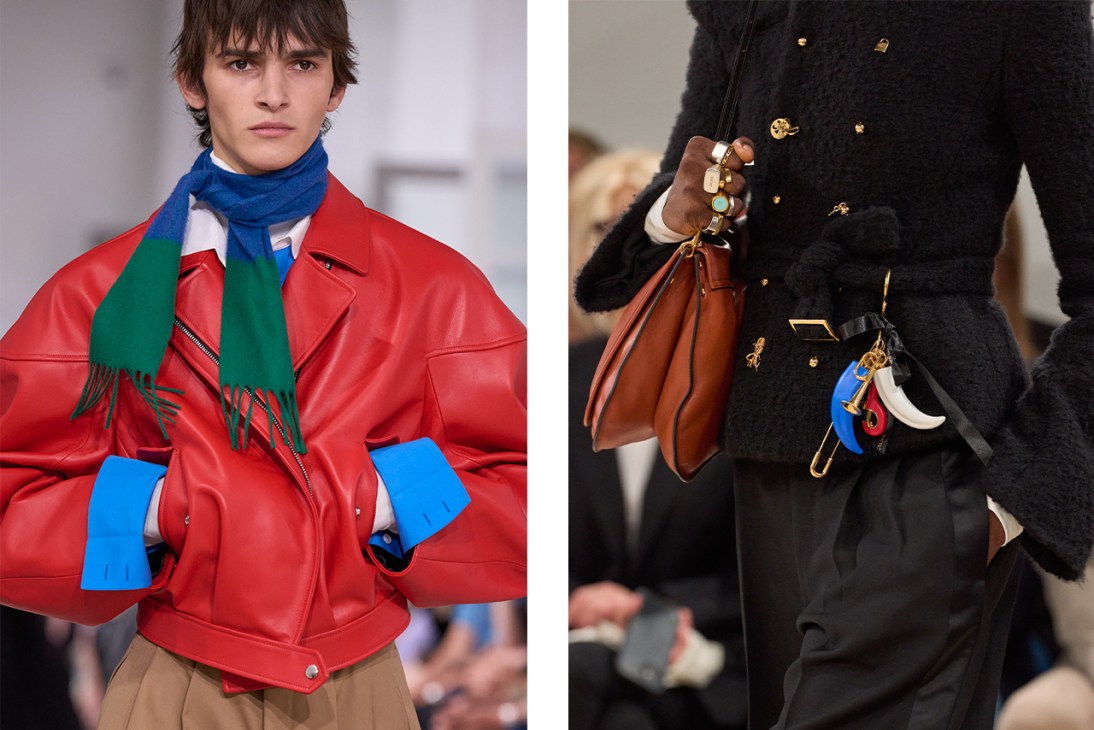
For the luxury-fashion industry, the first half of the year was mired with speculation – amusing at first, exhausting soon after – about musical chairs inside C-suites and design studios of brands in Milan and Paris. Now, with a new set of creative directors installed in these sought-after positions, attention has been redirected towards their high-stakes runway debuts. In the coming months, about a dozen houses will present fresh visions under renewed creative leadership. Brand owners and CEOs will be sitting on the edge of their front-row seats, waiting to see whether they made the right hiring choices and whether their balance sheets stand a chance at recovery.

In the case of LVMH-owned Celine, CEO Séverine Merle and group CEO Bernard Arnault no longer have anything to worry about. American-born Rider isn’t new to the French house: he spent a decade working under Phoebe Philo before moving to Polo Ralph Lauren, where he helped to reignite excitement for the label.
In this new position, which he described as a homecoming and a “complete joy”, Rider has been thrust further into the spotlight. He finally has a chance to get the credit that he deserves and to make a bigger impact on the industry at large. A star is born.
For the first time in more than a century, Parisians have been allowed to swim in the Seine. Three outdoor bathing areas opened to the public this weekend amid a searing heatwave, though authorities had to temporarily close them in response to a heavy downpour as Paris’s 19th-century sewage system has a habit of overflowing. Nevertheless, residents turned out in force for their opening on Saturday, with many expressing delight at the opportunity to cool off, despite long queues. As the Seine is one of Europe’s busiest waterways, every swimmer had to be tethered to an unsightly inflatable yellow lifebuoy. Le Parisien is already asking whether the rubber-ducky hue of the ugly personal floats will be the colour of the summer.
The reopening of the Seine to the public for the first time since the 1920s is a triumph for the city’s mayor, Anne Hidalgo. She spearheaded the creation of these free-to-access swimming spots, which were promised ahead of the 2024 Paris Olympics. The initiative is part of the Paris Plages project, which was launched in 2002 by the then-mayor, Bertrand Delanoë, who sought to turn once-dull riverbanks into sandy beaches.
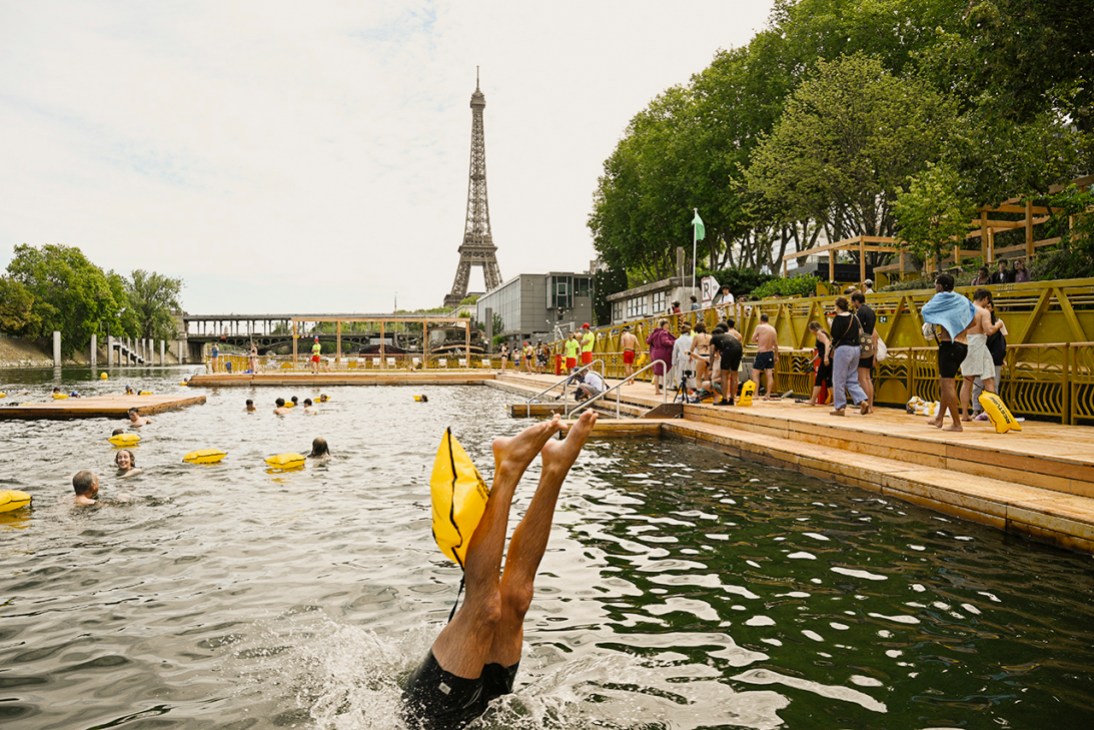
Some €1.4bn were spent on cleaning up the Seine, while millions more were lavished on constructing the swimming spots. The vision of a Paris that makes full use of its famous waterway is finally starting to take shape.
The move is Hidalgo’s most significant step towards recentring the French capital around its public spaces. It follows her extension of Paris’s cycle lanes and the permanent closure of Rue de Rivoli to most private vehicles. The expansion of her ambition to the Seine’s waters is not only highly symbolic but also smart public policy: this month’s intense heatwave has underlined how unprepared Paris is for extreme weather. The city’s historic buildings, with their lack of air conditioning, are ill-equipped for the summers to come. A swimmable Seine will go some way towards making future heatwaves easier to endure. But the project will only be successful if its current capacity of 600 swimmers across three sites is increased and the city finds a way to keep people swimming throughout the summer.
Hidalgo has been criticised for some of her costlier efforts to remake Paris, which might have scuppered her one-time presidential ambitions. But a swimmable Seine is a big achievement for the capital, which has changed more during her stewardship than under any of her recent predecessors. Dive in and see for yourself: Paris has finally joined the ranks of great cities where it makes sense to keep some swimwear and a towel to hand as you explore. Just make sure that your trunks don’t clash with yellow.
Bouvier is Monocle’s Paris bureau chief. For more on city swimming and improving urban waterways, listen to our report from the Swimmable Cities Conference in Rotterdam.
Tróia, a coastal peninsula just south of Lisbon, is little more than a 15km sliver of sand. Here, pristine dunes form a barrier between the Atlantic and the estuary of the river Sado, with villa after villa of the well-heeled Alfacinhas (Lisbon locals) lining the coast. Holidaymakers can choose to spend their day on an uninterrupted golden beach where the waves crash in from the ocean or jump across to more secluded waters, where a pod of bottlenose dolphins also swim.
As a project site for a Lisbon-based architect, it doesn’t get much better than Tróia. It is exactly what landed on the desk of Inês Cortesão, founder of Bica Arquitectos. Lisbon financier Vasco Machado came to her with an oceanfront plot in the middle of the peninsula – one of the last available – and an almost carte-blanche design brief for a holiday home to host family and friends. “Everyone’s dream place to live is in a house by the sea,” says Cortesão. “It’s a dream to design one too.”

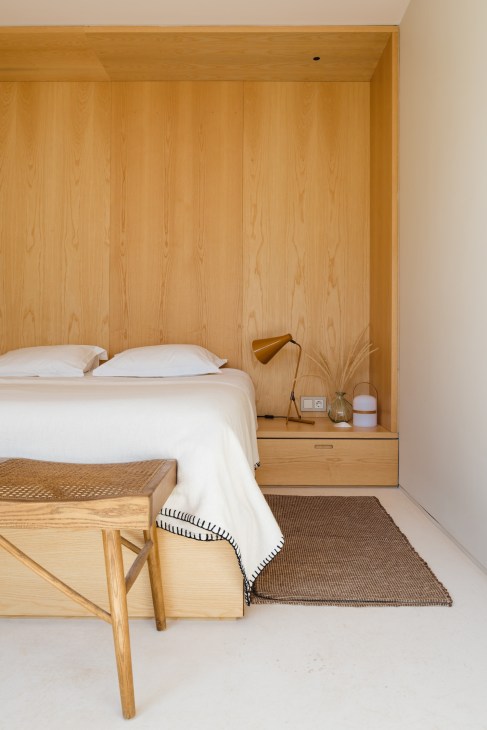
The commission wasn’t all carefree: the land is inside a gated community, with a close neighbour on one side and a communal pathway to the beach on the other. The project needed to provide plenty of privacy while being sensitive to its built and natural surroundings. But Cortesão, who shows Monocle around on a sunny summer Saturday (while friends are visiting for a swim and some holiday sun), didn’t have to think long about the concept. “I’m not the kind of architect to make drawing after drawing,” she says. “The location is so strong that knowing what to do was intuitive.”
For the architect, the only solution for building on the dunes was to mimic them. On entry, the home reveals itself immediately: there is a long corridor that opens to a combined living room, kitchen and pool area, while six bedrooms are spaced out symmetrically on each side. The key architectural element is a four-metre-high wall of fir planks that wraps around the building’s exterior, directly inspired by the wooden palisades typically built on dunes to keep the sand in place and to demarcate property.
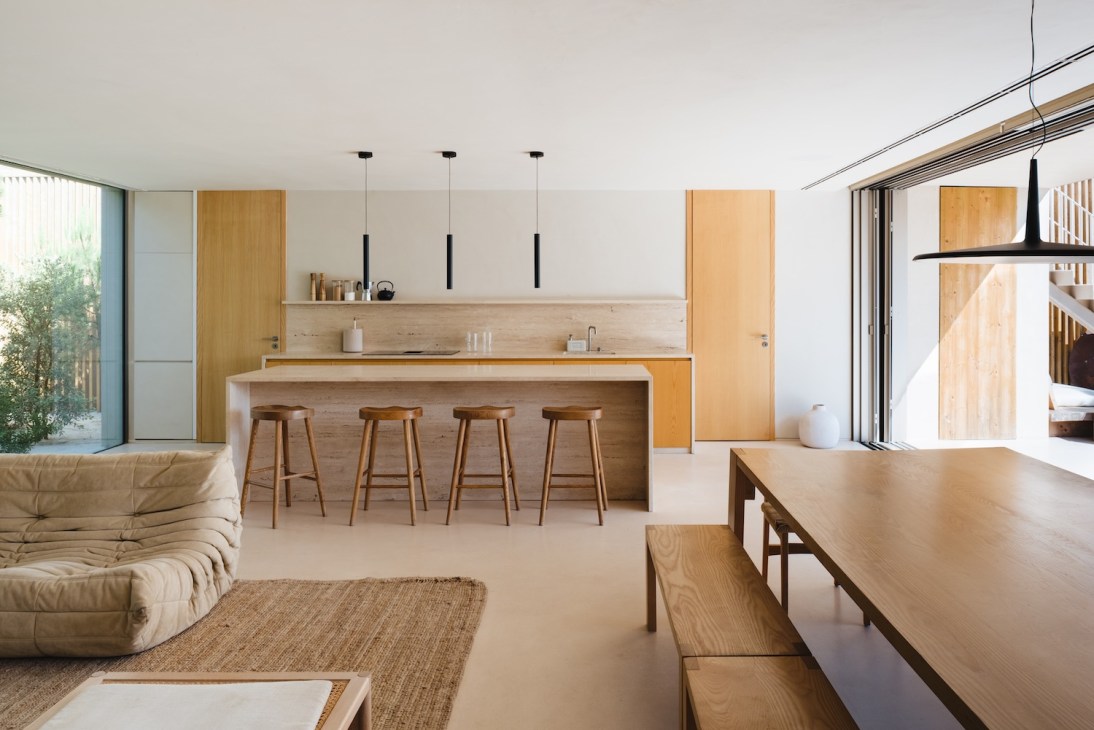
Playing a key role in the building’s design is the surrounding landscape. Together with landscape architect Mariana Mendes, Cortesão created a buffer of sand around the pool so that sunbathers aren’t visible from neighbouring properties. All around the building, Cortesão planted stone pines, marram grass and flowering shrubs that are native to the dunes. The interiors also continue the sandy theme, with grainy plaster floors, heavy travertine kitchen surfaces and custom-made fixtures in honey-hued ash. Cortesão herself is dressed like an extension of the house in a cream knitted dress and rattan sandals. “I can’t separate architecture and design in my work,” she says. “It’s all one; there has to be harmony.”
This holistic, no-nonsense approach is why Machado tasked Cortesão, who had previously designed his apartment in Lisbon, with the project. “She’s not only an architect but she knows how to do everything,” he says. During the construction process, Cortesão, who has completed more than half a dozen standalone villas, was at the building site every week, fussing over details and keeping an eye on the builders. “With someone like Inês, you know it’s going to work out,” adds Machado. “She’s really picky.”
Machado grew up spending his summers in the nearby village but he currently lives in Spain. He stays in Tróia in both summer and winter together with his wife and four children. “Even at night the kids walk freely in and out,” he says. “It’s total liberty. The door is always open.” Unsurprisingly, his favourite part of the house is the pool, which Cortesão designed to slope down like the seashore and coated with a mortar mixed with sand from the area. “It was Inês’s idea to make the pool resemble the beach,” he says.

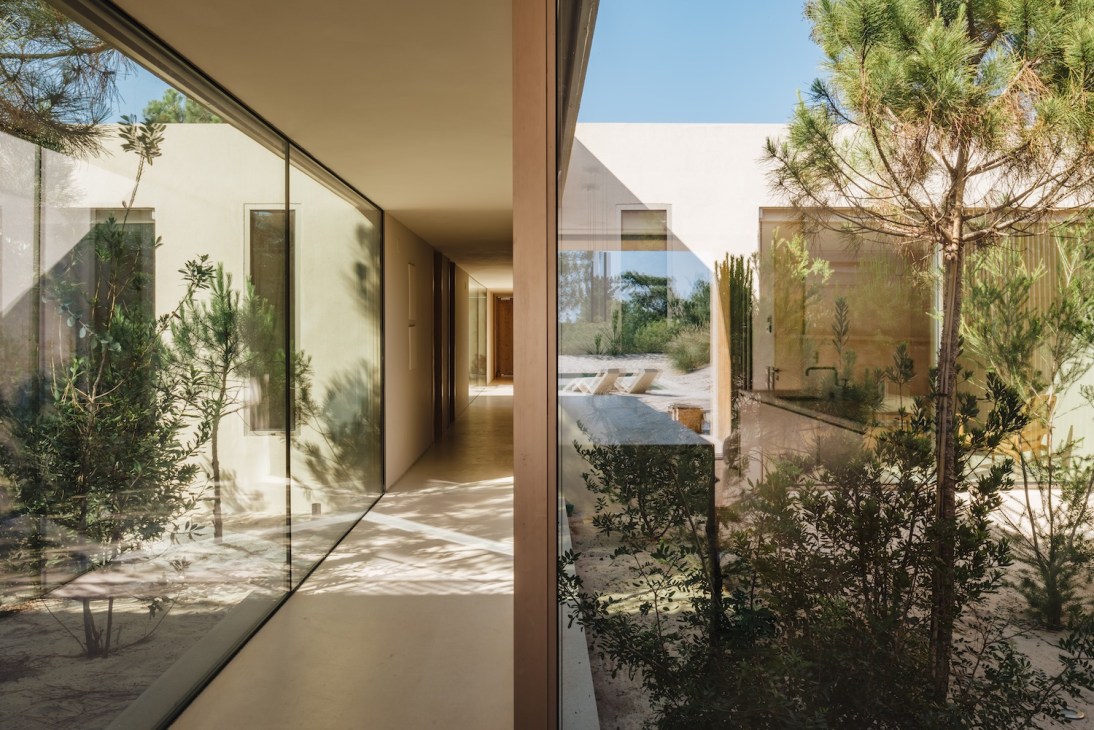
Cortesão’s only qualm about the house relates to the pool area, where there once stood a scraggly, sculptural pine tree. The architect had gone to great lengths to preserve it and oriented the entire house around it. “That pine was the protagonist of the central corridor,” she says. Suddenly, just three months before construction completed, the needles turned yellow. In its place is now a smaller, straighter specimen that acts as the home’s focal point. But Machado is giving the young pine, like the house, time to grow into its own. “I’ll only consider this project done when the house appears like being inside a forest,” he says.



